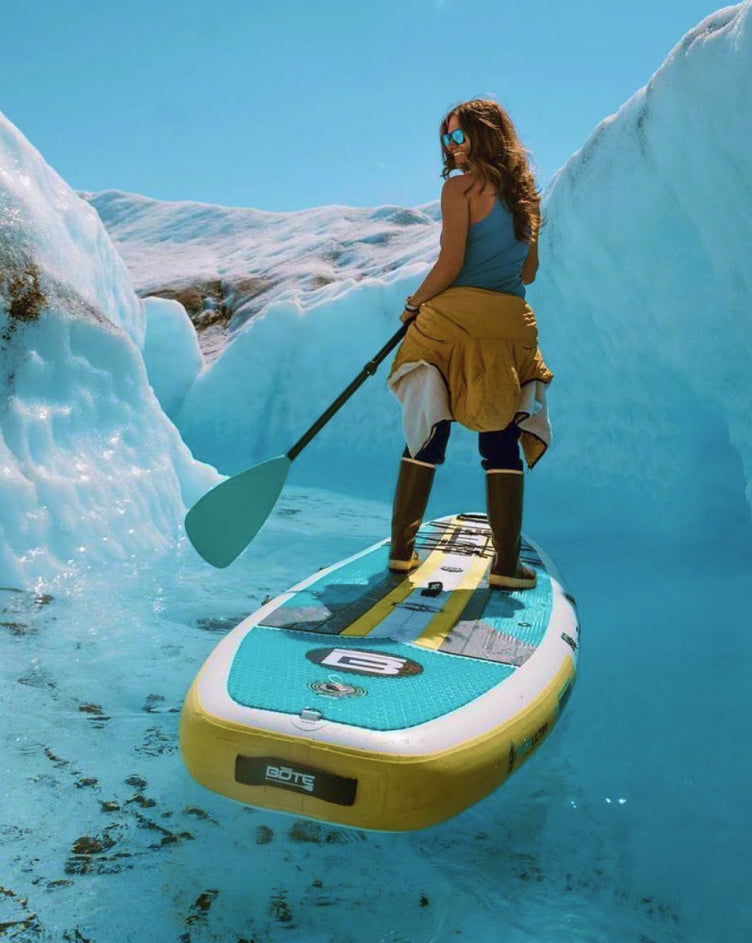Getting to the Water: How to Vehicle Mount a Stand Up Paddle Board
We hear a lot of first time solid stand up paddle board buyers say they’re concerned about safely transporting their SUP. Since our inflatable paddle boards and aero kayaks can be deflated, packed into a bag, and tossed in any size trunk, these are the most travel-friendly product options. But for those who like to go fast and work as efficiently as possible in the water, a solid stand up paddle board is the way to go, and transporting it is easier than you may think.
Whether you have a Toyota Prius or a lifted truck, a stand up paddle board can be safely mounted to any type of vehicle. Sure, the first time you drive off with a 10- or 12-foot stand up paddle board on your roof you’ll glance back in the rearview fifty times before arriving at your destination to make sure it didn’t fly off, but if you follow these simple instructions you’ll be a pro in no time.
How to Transport a Stand Up Paddle Board
If you’re trying to figure out how to vehicle mount your paddle board, we’ve removed the guesswork by compiling a list of the best ways to mount a stand up paddle board on virtually any vehicle, including sedans, crossovers, SUVs, and trucks. Mounting a stand up paddle board to a vehicle the right way will give you peace of mind that it’s secure and protected from major scratches and dents.
To get started, check out this quick how-to video with our Fort Walton Beach retail associate and resident paddle board vehicle mounting pro, Matt.
Next, we’ve outlined step-by-step methods below for vehicle mounting your stand up paddle board to three vehicle types: without a roof rack, with a roof rack, and truck tailgate.
Mounting a Stand Up Paddle Board Without a Roof Rack
If you fall into the category of someone who owns a sedan or crossover vehicle that doesn’t have a roof rack, we created a solution specifically designed for you. Keep in mind this solution does not work well for interstate travel and long distances, but does the trick for getting around town.
What You Need
- BOTE Quick Strap Board Rack
- BOTE Board Sox or a Board Bag to protect from dents, scratches or UV damage.
Need to Know
Soft racks are intended for shorter trips and are not recommended for speeds exceeding 55 mph.

How to Do It
- Place the pads a few inches from the front and back windshields where the car frame is strongest. Open all four doors, feed the straps through and secure inside the car.
NOTE: You don’t want the pads too close together, which could make your board unstable while driving, especially with longer boards. BOTE recommends four to eight inches back from each windshield, depending on the length of your car. - Load your stand up paddle board from the side of the car, with the fin facing up and toward the front. We highly recommend a board bag or sox for added protection.
- Tighten the top straps to secure your stand up paddle board. Before you buckle, twist the strap to avoid annoying buzzing noises while driving.
- Once tightened, secure excess straps by either tucking inside the car door or tying off.
- Before you head out, grab the side of your stand up paddle board and try to move it to make sure it’s secure.



Soft racks are intended for shorter trips and are not recommended for speeds exceeding 55 mph.

Mounting a Stand Up Paddle Board With a Roof Rack
So you have a crossover or SUV with a roof rack. Good, you’re almost halfway there.
What You Need
- BOTE Roof Rack Pads
- BOTE Board Sox or a Board Bag to protect from dents, scratches or UV damage.
- Cam Straps (or, for added safety, Locking Cam Straps like KanuLock Lockable Tie-Down Straps or Thule’s locking straps)
Need to Know
- If your roof mounting system doesn’t include crossbars you can purchase them from dealers such as Yakima or Thule. Some vehicles, such as a Subaru Outback, have fold-out crossbars.
- Look for cam straps that have a protective element over the metal buckle to protect your board and car from scratches. Never use ratchet straps as they can cinch down too tightly and damage your board.
- If you’re only transporting one stand up paddle board, 11-foot straps will work. For two or more boards we recommend 13 foot or longer. Always stack boards largest to smallest and if you aren’t using a Board bag or Sox put paddling better your gatorshell or epoxy boards.
Look for cam straps that have a protective element over the metal buckle to protect your board and car from scratches. Never use ratchet straps as they can cinch down too tightly and damage your board.
How to Do It
- Secure BOTE Roof Rack Pads around your vehicle’s cross bars.
- Load your stand up paddle board onto the roof rack with the fin facing up and toward the front of the car. We highly recommended using a board bag for added protection.
NOTE: You can load your stand up paddle board from the side of your vehicle or by sliding it on the rack from the back (this is easier for taller SUVs). - Holding onto the buckle of your cam strap, loop it under the front crossbar and toss the slack over your stand up paddle board.
- Loop the tail end under the other crossbar and throw it back over the board.
- Feed the strap through the buckle and tighten. If you twist the strap before buckling you will avoid annoying buzzing noises while driving.
- Repeat steps 3-5 on the rear crossbar.
- Secure excess straps by either tucking inside the car door or tying off.
- Before you head out, grab the side of your stand up paddle board and try to move it to make sure it’s secure.
There are also other tools like the Thule SUP Taxi that can help to simplify the process even further, particularly if you want to skip the straps and make a stand up paddle board mount a more permanent fixture on your vehicle.



Mounting a Stand Up Paddle Board With a Truck Tailgate Pad
We see you and your beloved truck. Your vehicle was built to haul, so we’re going to focus on securing and protecting your stand up paddle board.
What You Need
- BOTE Tailgate Pad
- BOTE Board Sox or a Board Bag to protect from dents, scratches or UV damage.
Need to Know
- Always load your stand up paddle board fin side first to avoid damaging the nose of your board.
- Make sure your tailgate is long enough for your stand up paddle board. At least half of the board should be inside the truck bed.
- You may need/want to tie a red flag to your board bag since your board will be sticking out 5-7”

How to Do It
- Lay the pad on top of your tailgate. It can be positioned anywhere (left, center or right).
- Feed the straps on either side of the pad under the tailgate and between the bed of the truck. You may have to crack the tailgate loosely. Feed strap through buckle and securely tighten.
- Undo top tension strap and load stand up paddle board into truck bed. We highly recommend a board bag or sox for added protection.
- Fasten and tighten tension strap to secure board.
Always load your stand up paddle board fin side first to avoid damaging the nose of your board.

Other Things to Keep In Mind
As you can see, it doesn’t take much to mount your stand up paddle board to any type of vehicle. However, if you’re mastering how to transport a stand up paddle board like a pro, we have a few more tips our team and BOTE Nation crew swear by.
- Do not use ratchet straps as the pressure could damage the board, cam straps with buckle bumpers are best. We recommend Thule Load Straps.
- Worried about someone stealing your SUP? Some straps come reinforced with lock sand stainless steel cables to prevent them from being cut or removed. For extra protection from theft, KanuLock Lockable Tie Down Straps and Thule Locking Straps are both great options.
- Summer sun can be brutal, and even an epoxy seal can’t protect your board from endless sun exposure. If you’re taking a cross country road trip or generally plan to store your board on top of your car in between use, consider Board Sox to protect your stand up paddle board. Bonus: Board Sox can double as a protective sleeve when your board is laying on the beach. And while we don’t recommend dragging your board, Board Sox make it a hell of a lot easier to drag your board across the sand when you don’t have the strength to carry it long distances.
These are the vehicle mounting methods we use at BOTE and recommended by BOTE Nation. Have you tested them out? Have any other ideas? Share your own how-to video on Facebook or Instagram and tag us at #BOTEBOARDS and #BOTENATION.
Have questions? Call us directly, send us a message on our social channels, or chat with us via our website at any time to learn more about how to vehicle mount your stand up paddle board like a pro.












